How the first stage of the Moscow Metro was built
Categories: History
By Pictolic https://pictolic.com/article/how-the-first-stage-of-the-moscow-metro-was-built.htmlOn May 15, 1935, the first line of the Moscow Metro was opened, which ran from the Sokolniki station to the Park Kultury station, with a branch to Smolenskaya
Alexander Popov aka Russos writes: “Several years ago I came across a pack of old photographs from the editorial office of the Metrostroyevets newspaper. They were scanned and permanently buried on the hard drive. Now I will show them to you. A dozen photographs were signed on the reverse side. On some more, you can guess what object is depicted on them or what the metro builders are doing. And on some it is impossible to determine where the bottom is, and where the top is. But for each I will try to give at least some commentary.
(Total 74 photos)
 Source: Journal/russos
Source: Journal/russos
Mine No. 18 (Station "Chistye Prudy", then - "Kirovskaya").
A.G. Tankelevich, head of mine No. 18-18-bis: “Underground, at a depth of 40 meters, in the most difficult geological conditions, it was necessary to build a huge three-vaulted palace with large halls, spacious lobbies, and wide corridors within a year. For this construction, it was necessary to apply new, hitherto unknown methods, to master unfamiliar technology on the go. It was necessary to do a huge job of excavating the soil, laying tens of thousands of cubic meters of concrete. It was an honorable task, and it was very interesting to solve it. There was a lot of work."
Mine No. 20 (the stage "Chistye Prudy" - "Red Gate"). It is noteworthy that it was passed by the method of artificial freezing. It was a dress rehearsal before the slant run with freeze.
P.P. Rotert, head of the Metrostroy: “Various methods of sinking these inclined shafts have been proposed. They could be passed with compressed air. However, given that they pass under streets with heavy traffic, partly under houses, we felt that when working with compressed air in such conditions, it is necessary to have a full guarantee that there will not be any interruption in the supply of electricity, since in this If so, a major accident could occur. Not wanting to take a risk, we decided to use the freezing method using deviated boreholes for this job. This method was previously tested on Shaft 20, which we drilled specifically in this way in order to prepare for the more serious task of sinking inclined shafts.”
One can only guess where the rest of the shots were taken, but with a high degree of probability they could have been taken there.

1. Flooded trunk. I can assume that this is mine No. 20 (“- Comrades ... The twentieth mine was flooded ... There is no energy, the pumps are not working. The water was rapidly increasing. The 20th was passed by a driven metal tongue, and the water went through it with great speed and force. "From here) , but in fact we see a flooded trunk with a ladder going down.

2. Caisson devices. In the background is a building with a sign: “Hairdresser No. 3. *-* Trust of the Sokolniki District.

3. Ibid. In the foreground, you can guess the collar of the mine.

4. Well, yes, this is a mine. Workers are busy with the caisson apparatus.

5. Judging by the steam and the metal tongue, this is a pile driver for driving it.

6.

7.

8. Fossil.

9. Some work in the trunk. By today's standards, TB, of course, is terrible - the workers did not even have helmets. But for those times it was considered quite acceptable.

10. It seems that the tongue is being driven again. Let me remind you that there were a lot of shaft sinking technologies at that time. Including driving with a tongue along the contour, and excavation.

11. Trolley in a cage at the top of a copra. It's cold outside, judging by the icicles.

12.

13.
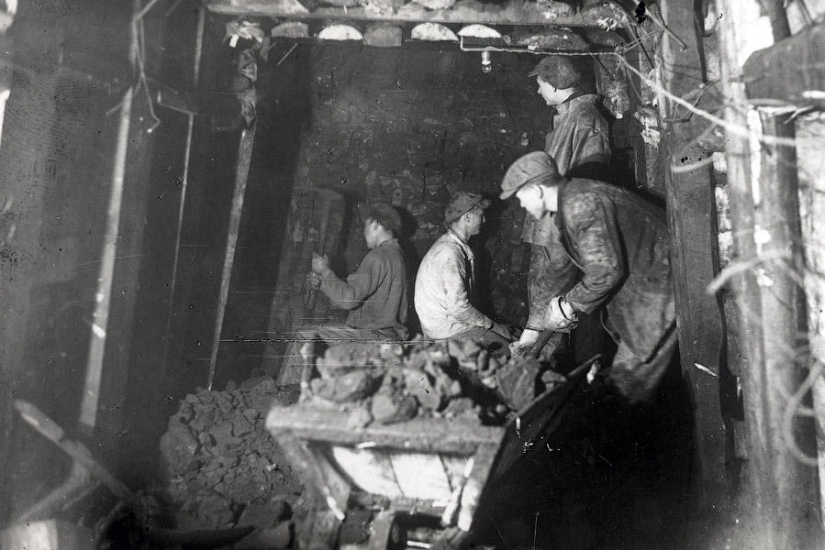
14. In the bottom of the adit.

15. Adit.

16. Judging by the circles in the foreground, this is the preparation of the calotte for concreting.

17.

18.

19. Detail of the caisson.

20.

21. Old photoshop. Apparently, editing for layout.

22. They cut out what they needed from the photo, put it on white paper and re-shot it again.

23. Caisson apparatus installed in the mine.

24. Another fossil.

25. In the trunk. On the left is a large reservoir (most likely for compressed air), on the right is some kind of pump. Maybe a water drain.

26. Compressor. American. It says "CHICAGO PNEUMATIC TOOL"

27. Vault lock. What is most interesting is that it is made of stone, and not of monolithic concrete.
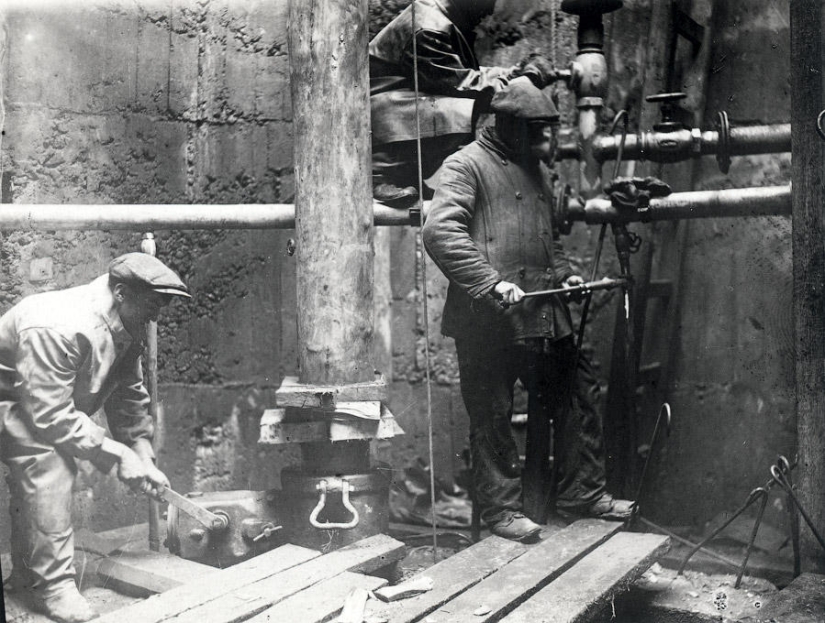
28. Jack with a log.

29. Excavated rock?

30. It is not clear where the top is here, and what this design is intended for. Some kind of hammered wedges into metal tubes.

31.

32. It seems that this is already an open calotte, but not yet concreted.
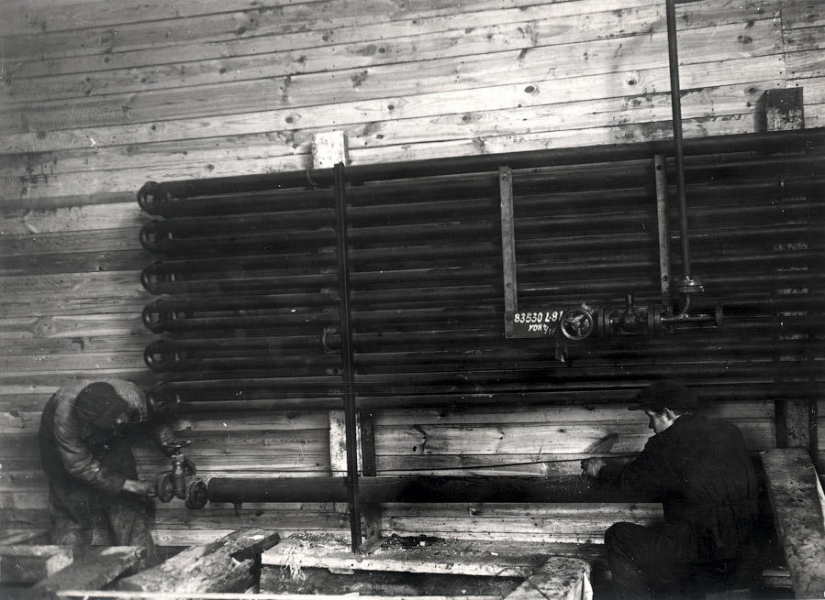
33. Radiator?

34. Mine on the street. Well, connoisseurs, do you recognize the street?

35. Dewatering?

36. Some kind of radiators.

37.

38. Mine shaft. Note the crack in the concrete marked with arrows.

39. Apparently, this is the concreting of a bridge in the shaft between the zones of high and normal pressure. The caisson pipe sticks up. The apparatus itself, where compression and decompression takes place, will be on top. Remember those big barrels in photo #4?

40. Executions led. Rather, they are squeezed by rock pressure.

41. A man is behind the execution. Pay attention to the scale.

42.

43. Ruddyard of the mine and issuance of rock in a canoe up?
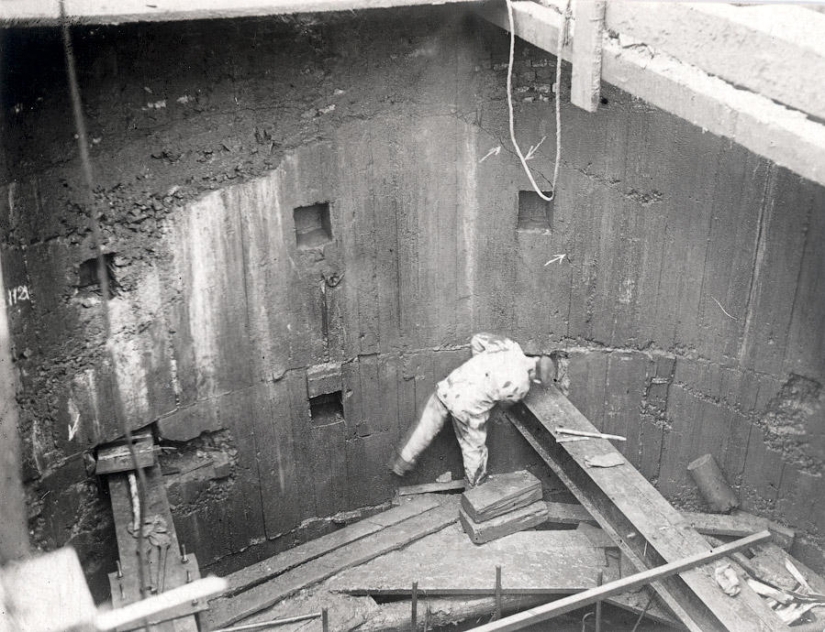
44.

45.
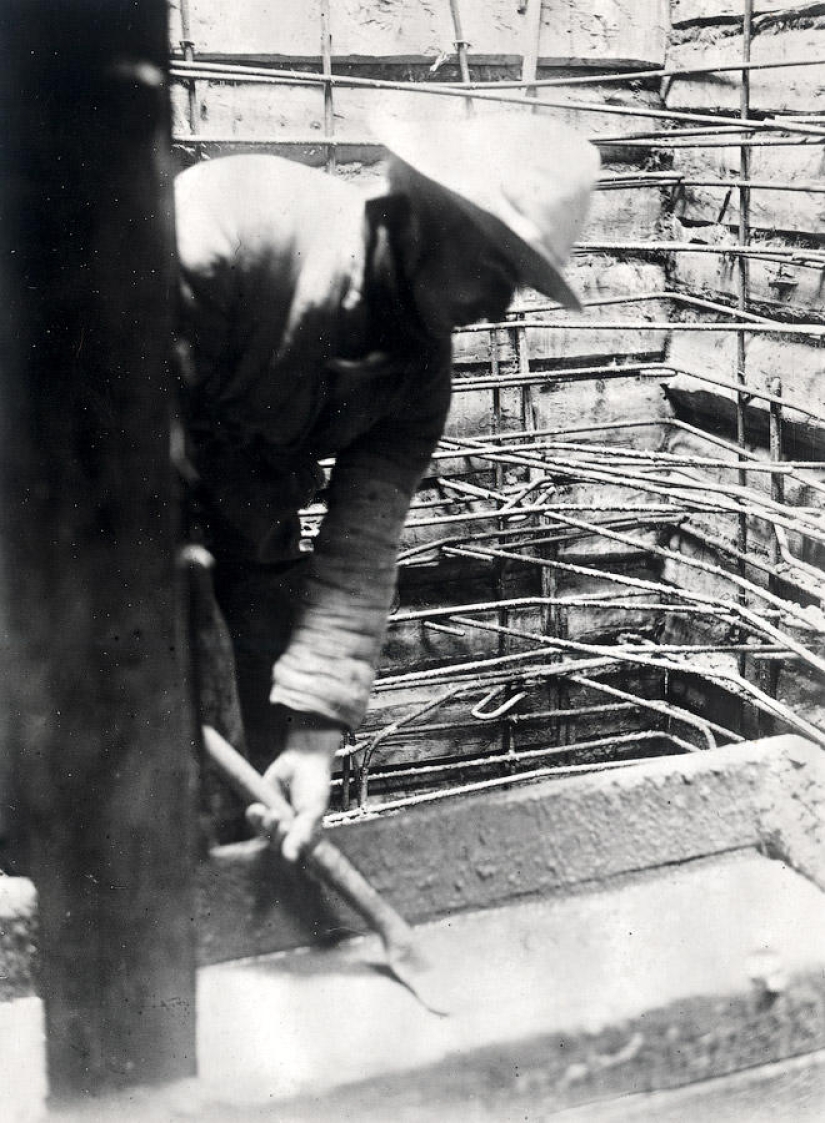
46.

47.

48. Seems to have oriented correctly.

49.

50.

51.
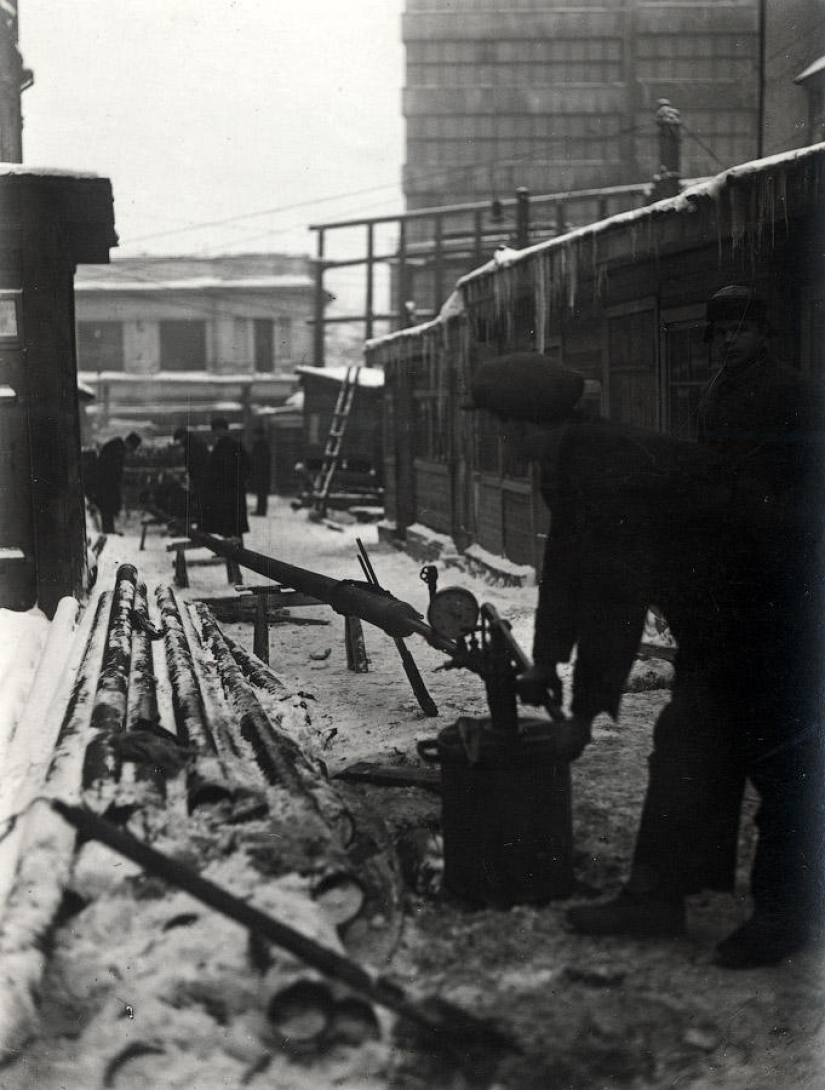
52.

53.

54.
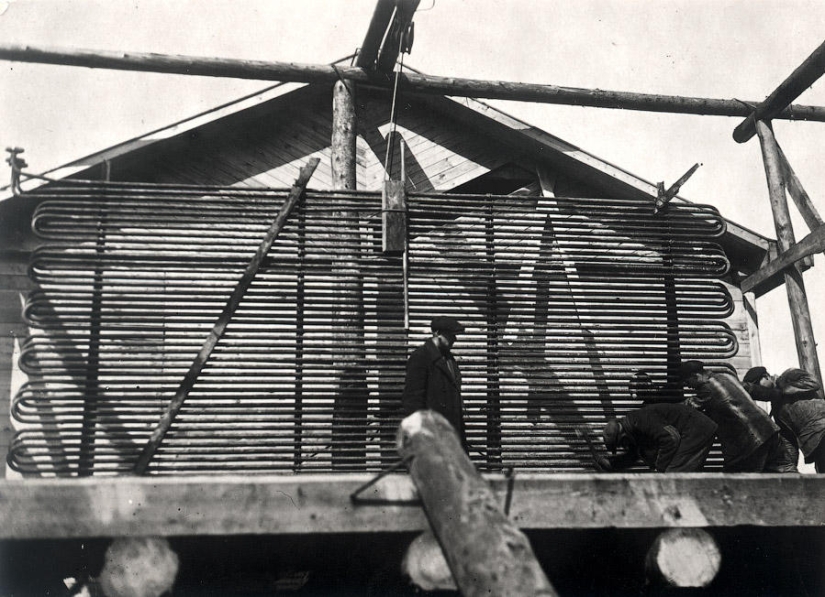
55. Installing a radiator.

56. Fine-tuning with a sledgehammer.

57. The radiator is almost assembled. I don't know what it is for. Maybe the freezing system at Mine 18, or part of any compressor station?

58.

59. The inscription on the back says that the photo shows the installation of some ring of the 18th mine. Most likely, two annular contours for freezing are meant. By the way, look at the stairs down: no insurance and rings behind your back.

60. Turnover: Mine #20. Assembling a metal sheet pile in the face of a mine.

61. Rev.: Castle vault.

62.

63. Turnover: Mine No. 18. Knife segments.

64. Rev.: Samples of excavated rock.
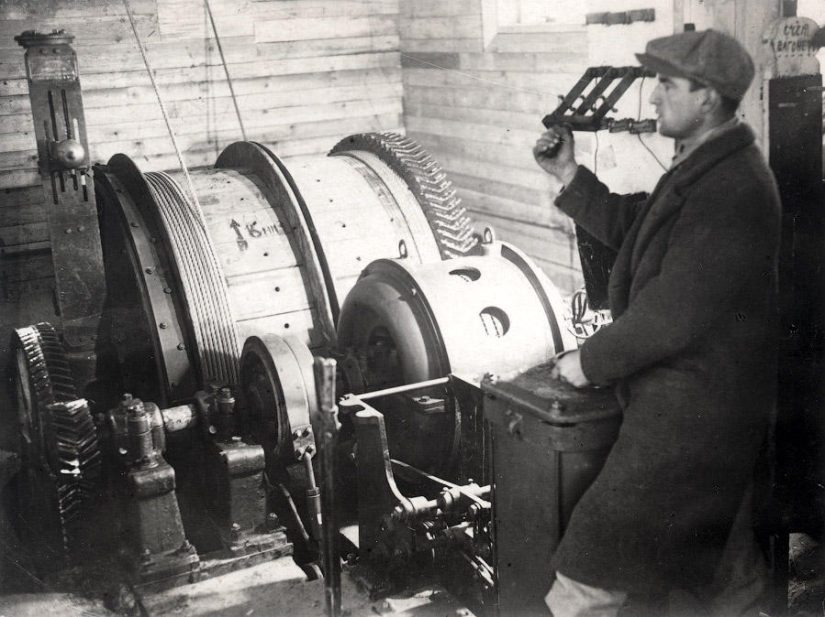
65. The signature on the back is unreadable, but it is clear that this is a cage hoist. By the way, even after 80 years, trolleys are considered the same as then - sticks stuck into the boards.

66. Turnover: Mine No. 18. Preparation of formwork, circling and reinforcement of the foreshaft collar.

67. Turnover: Mine No. 18. Stripping of the foreshaft.

68.
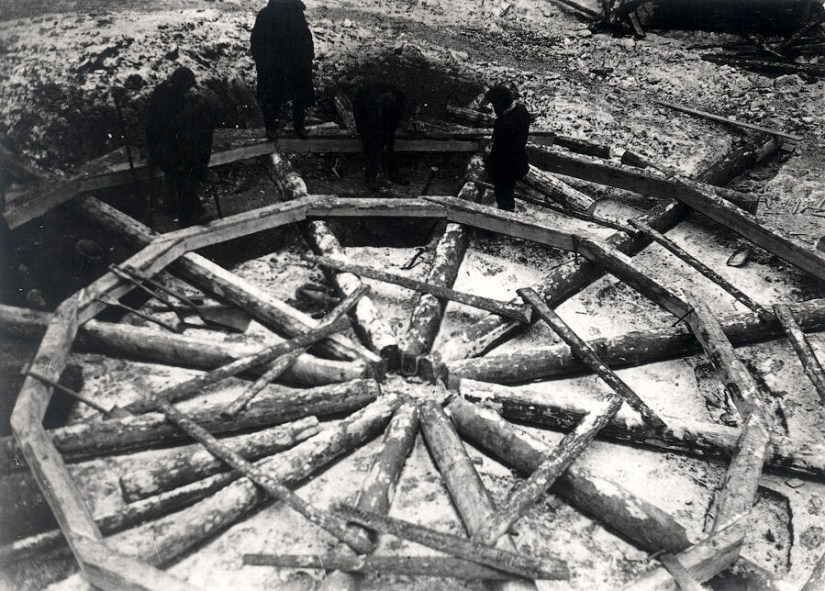
69.

70. Turnover: Mine No. 18. Horizontal drilling.

71.

72. Turnover: sh. 23. Installation of fittings g. b. shell edge **** mine. Taken on 29 IV 33
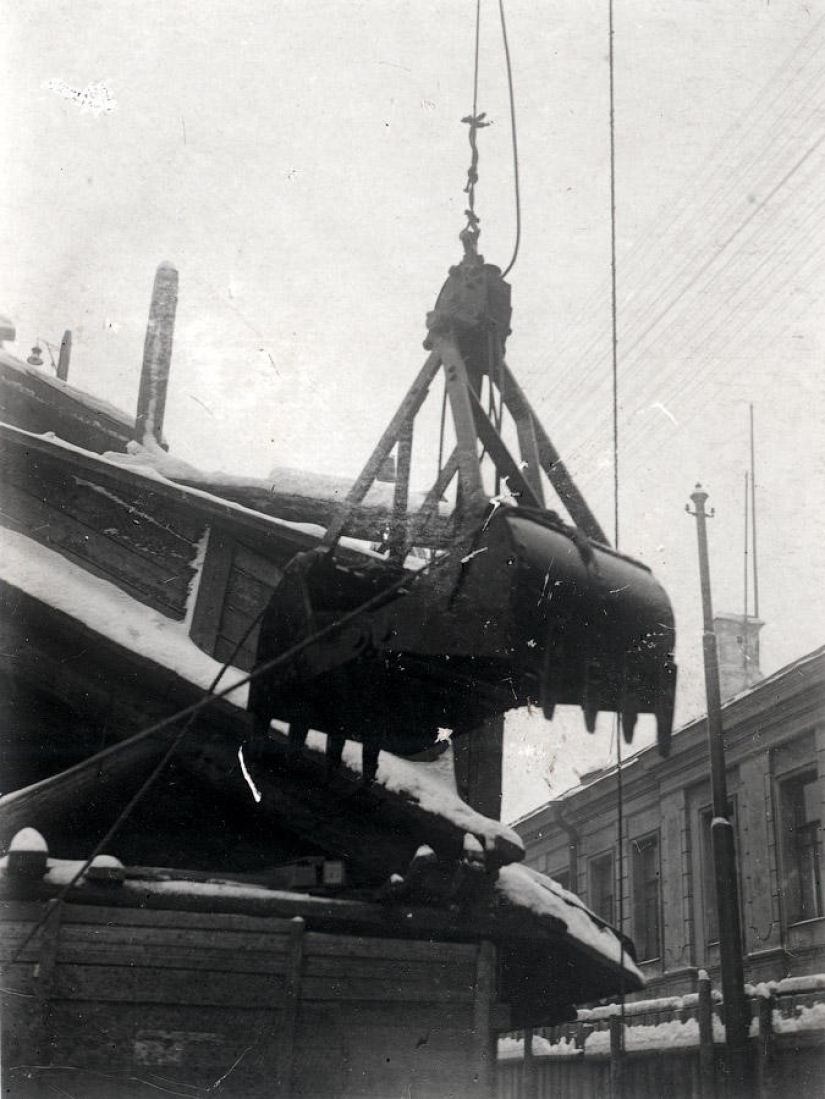
73. Turnover: Mine No. 18. Grab in open form.

74. This photo was in the same pack, but it accurately depicts the construction of the second or later stage, because. there are no distillation tunnels made of cast-iron tubing at the first stage.
Keywords: Metro | Subway | Moscow | Pervyy | Construction | Transport
Post News ArticleRecent articles

There are many stories of children disappearing without a trace. Much less often, they appear out of nowhere, as happened on May ...

Kerem Cigerci is a 19-year-old digital artist from Istanbul. Despite his young age, he is not a novice in his field. Kerem has been ...
Related articles

The first half of the 70‑ies of the last Soviet schoolchildren under the sign of gum. Imported, of course, because domestic had ...

Many contemporary photographers have specialization. Some only shoot weddings and wedding, others like the kids of preschool age, ...

Fires in ancient times was a terrible enemy of Moscow. The entry of the first Moscow fire is dated in the annals 1177 the year when ...

In the early Middle Ages, there was a special method of justice known as the Court of God. It was usually used when ordinary ...